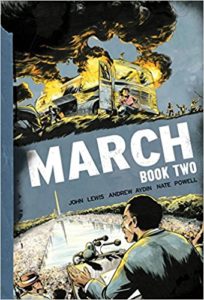 March: Book Two is the second in a series of three graphic novels that provide a vivid look at the civil rights movements in the United States.
March: Book Two is the second in a series of three graphic novels that provide a vivid look at the civil rights movements in the United States.
The March series focuses on the life of John Lewis, who is a United States Representative who represents Georgia’s 5th District. John Lewis is a Democrat. Before you read March: Book Two, you should read March: Book One. Doing so will make it clear what happened before the events in March: Book Two and how they led to what happens next.
The March series was written by John Lewis and Andrew Aydin. The art was done by Nate Powell.
As in the first book, March: Book Two includes scenes that are juxtaposed but that are not chronological. It eventually becomes clear that some of the scenes focus on John Lewis getting ready for, and attending, the Inauguration of President Barack Obama. These scenes provide the reader with a necessary breath of fresh air after reading through scenes that include extreme violence.
March: Book Two starts by noting that the civil rights group that John Lewis was part of was successful at using non-violent civil disobedience to end the segregation of the lunch counters. Their next goal was to use the same strategy to end segregation at fast food restaurants, and cafeterias. Some of this resulted in acts of violence perpetrated by racist white people who wanted segregation to continue.
The group also used non-violent civil disobedience at movie theaters. At the time, the movie playing was The Ten Commandments. The white people who were behind the counter at the ticket booth refused to sell tickets to black people.
The group that John Lewis was a part of performed what they called a “stand-in”. Everyone got in line, waited their turn, and politely asked to buy a ticket for the movie. When the ticket seller refused to sell them one, they got right back in line. The police came and physically assaulted some of the black people who wanted to buy movie tickets, and arrested many of them.
Eventually, after great effort, some movie theaters in the South ended segregation in theaters. They started selling tickets to black people.
This graphic novel covers what happened during the 1961 Freedom Ride. Freedom Riders, some white, and some black, went to Washington D.C. and split into two groups. They bought bus tickets to New Orleans. The purpose was to protest segregation on busses.
Things got really violent. Some Freedom Riders were taken to jail. Others got beat up by angry, white, racists. Someone firebombed one of the busses that some of the Freedom Riders were on.
Despite this, the Freedom Rides continued. There was a point where journalists and photographers came to the bus stations and took photos of the violence. This sometimes resulted in the photographers having their cameras smashed, and their bodies beaten. Some of the photos made it to newspapers – and this helped spread the news of the Freedom Ride.
There was a meeting in a church where Dr. Martin Luther King, Jr. spoke to the people who were part of the civil rights movement. Angry mobs gathered outside waiting for people to come out. It must have been terrifying to be there.
There was a point where the racist white people, some of whom were encouraged by elected officials to be violent, attacked black children. A little girl was hit by someone driving a pick-up truck. A children’s march in a park ended when police turned fire hoses on the kids, and then threatened to send in dogs.
March: Book Two points out that in 1941, there were plans for a March on Washington. The idea came from A. Philip Randolph, founder of the Brotherhood of the Sleeping Car Porters. He asked President Roosevelt to ensure that black workers would be integrated into the growing war economy.
When Roosevelt refused, Randolph threatened to organize a March on Washington. This influenced Roosevelt to sign an executive order forbidding the defense industry from discrimination in hiring. So, the March on Washington was canceled.
In 1963, a March on Washington was planned, again. There were some shenanigans happening that almost resulted in John Lewis (and a few other people) from participating in the March. The full text of the John Lewis’s speech is included in the back of March: Book Two.
Obviously, this wasn’t the end of the civil rights movement. March: Book Three picks up from there, and provides details about what happened next. It may sound like it all happened a long time ago. The thing to keep in mind is that there are people alive today who lived through the events described in the March series, and who experienced discrimination and segregation.
March: Book Two – by John Lewis, Andrew Aydin and Nate Powell is a post written by Jen Thorpe on Book of Jen and is not allowed to be copied to other sites.
If you enjoyed this blog post please consider supporting me on Ko-fi. Thank you!

One comment